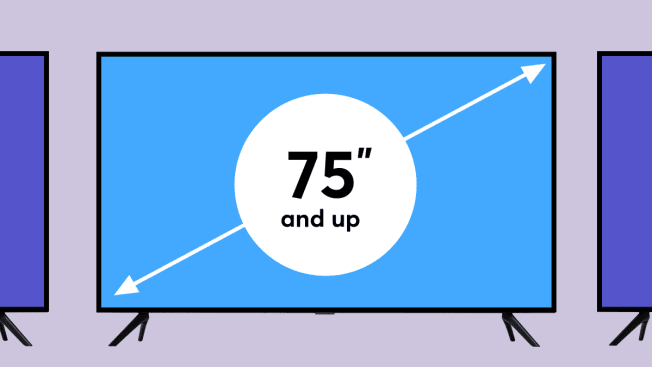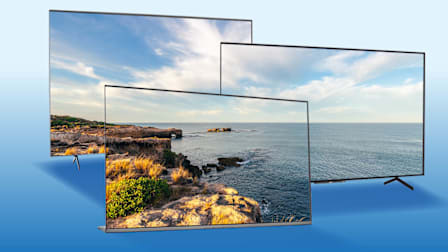Best 75- and 77-Inch TVs of 2025
These top-performing big-screen TVs include sets from LG, Roku, Samsung, Sony, and TCL—and some cost less than $1,000
When you shop through retailer links on our site, we may earn affiliate commissions. 100% of the fees we collect are used to support our nonprofit mission. Learn more.
TV shopping is a popular activity at this time of year, and if you’re looking to save money on a new set, you’ll have a lot of choices. Prices for very large TVs have dropped in recent years. And as you look around, you’ll find that retailers still have a mix of some leftover 2024 sets—often at their lowest prices ever—along with some new 2025 models that are now less expensive than when they were first introduced.
Buying a leftover 2024 set could be a particularly attractive idea, given the uncertainty about how much tariffs could eventually affect the price of newer sets. But if you are buying a 2025 TV in the next few months, see if you can get a price-match guarantee, in case prices drop shortly after you’ve made your purchase.
While the very best 75-inch sets remain relatively pricey, you can spend under $1,000 and still get a really enjoyable big-screen TV. Many of these less expensive TVs provide disappointing high dynamic range (HDR) performance, but you can find a few that do well with this technology. When executed at a high level, HDR can boost a TV’s brightness, contrast, and color, making the pictures on the screen look more like real life.
Most TVs on the market are LCD models, but OLED TVs have dominated our ratings for several years, providing rich, deep blacks and unlimited viewing angles. Thanks to improvements in backlight technologies, more LCD sets now offer performance that’s nearly as good. In general, OLEDs are more expensive, though prices have been falling recently.
Top-Performing TVs
You can’t go wrong with any of these sets. All are top-performing models with great picture quality and the ability to deliver a compelling HDR experience.
Note: All the LCD/LED sets below have 75-inch screens, while the OLED TVs come with 77-inch screens.
Best 75-Inch TVs Under $1,000
If you want to spend less, you can still get a big-screen TV that delivers very good to excellent overall picture quality. The trade-off is a more limited HDR experience.
How CR Tests TVs
The TV test team at Consumer Reports puts every TV through a battery of tests in our TV labs.
We first set up each TV and carefully note all its key features, such as resolution, number of HDMI inputs, and support for streaming services and voice-enabled digital assistants. We then set up the TV for optimal performance using the set’s built-in presets and picture controls. We use objective tests and measurements, as well as real-world video clips and subjective evaluations, to determine picture detail, color accuracy, and contrast.
We compare each TV with one of several fully calibrated reference TVs in our labs.
At Consumer Reports, TV ratings are based on hundreds of data points recorded by testers. Our ratings currently include more than 300 sets.
HDR, short for high dynamic range, is now found in a vast majority of midsized and large sets. HDR increases the contrast between the brightest whites and the darkest blacks a TV can produce. To do a good job with HDR video, a TV needs to get bright enough to display brighter, more colorful images with greater contrast and a wider array of colors, much closer to what we see in real life.
To test HDR performance, we measure a TV’s peak brightness using a $40,000 Photo Research PR-740 spectroradiometer (also used for measuring fine colors and deep black tones) and industry-standard and proprietary test patterns. We then evaluate the TV’s HDR performance with very dark and very bright scenes and video clips that feature an extended range of colors.
For viewing angle, we evaluate picture quality for clarity, color accuracy, and contrast at various horizontal and vertical viewing angles. Motion-blur tests, done at various speeds, evaluate how well a TV can produce a blur-free image during motion scenes.
Sound quality is evaluated using a TV’s built-in speakers in subjective testing by a trained listening panel, with support from audio test equipment. We listen for the overall quality of sound, the depth of bass, effective volume levels, and audible distortion during dialogue, music, and movie soundtracks. (Many TVs have disappointing sound in comparison with their image quality. You can address that by adding a soundbar.)
The versatility score measures a TV’s useful features, including—but not limited to—access to streaming services, the ability to work with digital voice assistants, the number of HDMI and USB inputs, and support for various media.
Finally, in recent years, we’ve added data privacy and security scores for all the TVs we test. Now that TVs routinely connect to the internet, data privacy and security have become concerns for consumers.
Consumer Reports evaluates the various ways TV brands collect, use, and share consumer data, how well they protect it, and how transparent they are about their data practices. We encourage TV makers to ship their sets to consumers with the optimal privacy settings turned on by default. You can also adjust the settings yourself.

































